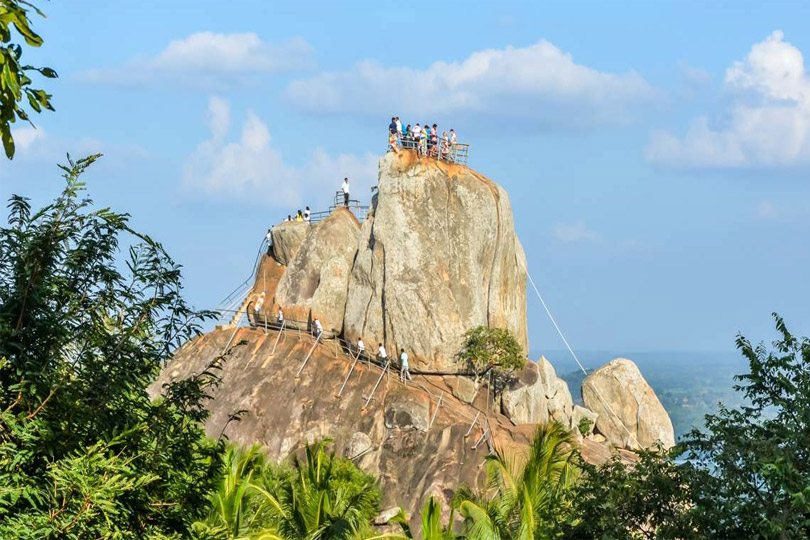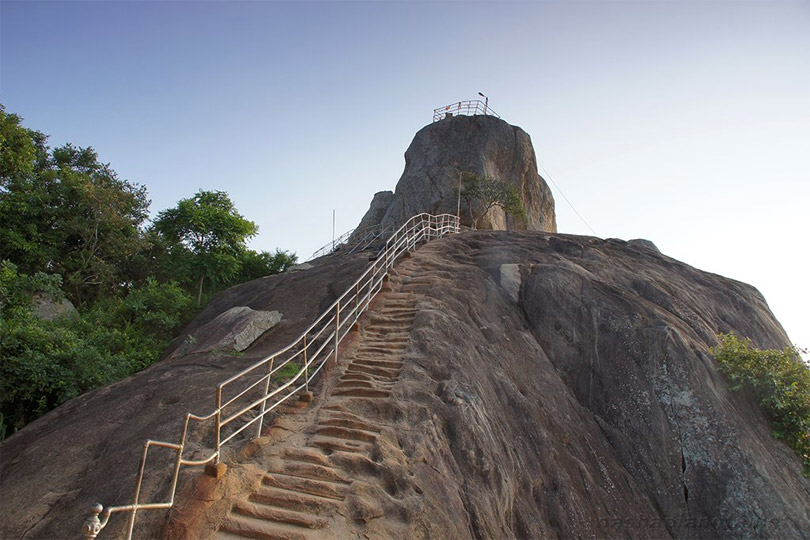
Mihintale
The king Devanampiya Tissa as well as king Uttiya too built monastery buildings, stupas, ponds etc. at Mihintale in third century B.C. Hence, many kings and royal family members built and renovated religious buildings in Mihintale up to King Keerthi Sri Rajasingha of Kandyan kingdom in the 17th century A.D. several remarkable development works can be highlighted among them. After passing away of Arahat Mahinda thera, King Uttiya had conserved the exiting ruins of buildings, stupas, caves, terraces, fight of steps, retaining walls, pathway etc. King Lanjjitissa (119-109 A.D.) built a chapter house, a stupa and also planted a Bodhi tree on the summit.
King Bhatikabhaya (22 B.C.- 7 A.D.) offered alms to two thousand resident monks.King Mahadathika Mahanaga (7-19 A.D.) constructed a street all across the hill and built Maha Seya (large stupa) at the top of the hill. He also conducted a festival, so called the Giribhanda puja (offering of goods same as a hill like amount).
King Kanirajanutissa (29- 32 A.D.) repaired the sacred buildings and settled a dispute among the monks at the chapter house in Mihintale. King Vasabha (67- 111 A.D.). Illuminated the whole sacred hill with thousands of lamps. King Kanitthatissa (167-186 A.D.) built a house of stupa or circular building (Thupagara or Vatadaga) for the stone stupa or stupa of plateau of mango trees (Sela chethiya or Ambasthala stupa). Sometime later,the Thupagara had been renovated by king Godhabhaya (249 -262 A.D.) king Jetthatissa (263-273 A.D.) offered a tank (Weva) called Kalamattika to the monastery.
Kig Sirimeshavanna (301-328 A.D.) made a golden statue of Mahinda thera and organized a procession carrying the sculpture from Mihinthale to Jaya Sri Maha Bodhi tree at Anuradhapura. King Dhathusena (455 – 473 A.D.) made the status of all monks of missionary including Mahinda thera and brought them to Anuradhapura in procession.
King Aggabodhi I (571-604 A.D.) made the pond Nagasondi or Nuga pokuna (Cobra's pond or Elephant pond) and supplied the bath with a continued supply of water. He built the tank Mahinda Vapi (tank of Mahinda) and ordered the figure of great thea Mahinda should be carried in procession across the bund of the tank.

King Aggabodhi III (628 A.D.) granted village called Ambillapadara to the monastery. King Aggabodhi V (718 -724 A.D.) renovated religious buildings. The queen of King Dappula II (815 – 831 A.D.) built a cave temple called as Ganasela and and donated Mahummara village to the monastery. She also built Katu Maha Seya (Stupa of thorns). It is believed that the implement used to build buildings at Mihinthale was enshrined in this stupa, but it is a fallacious opinion, because the archaeologists discovered only some copper plates written on Mahayana stanzas and a few coins during the excavation. She also built a nunnery of nuns. The queen cut down the branches of grown tall trees and offered flags and banners with multi colours to be hun. She conserved the Giribhanda stupa.
King Sena II (853 -887 A.D.) was the founder of the indigenous monastic hospital at Mihintale. The pillar inscription, which was erected at the hospital mentioned some donation given by the king. The Hadayunha Pirivena, so called Kaludiya Pokuna (Black Water Pond) monastery complex was built by Ilanga Sena, the commander in chief of King Kassapa IV (898 – 914 A.D.) it had been donated by him to the Dharmaruchi chapter (Nikaya) of the Mahayana Buddhist Sector. During this period Mihinthale was being converted as a center of Mahayanism and Theravada Buddhism was declining. It was a coincidence of decay of Anuradhapura during the latter part of the 11th century A.D. The kingdom and the capital was shifted to Polonnaruwa. King Vijayabahu, King Parakramabahu, and Kins Nissankamalla of the Polonnaruwa kingdom repaired the religious buildings at Mihintale in 12th century A.D. Thereafter, Kind Keerthi Sri Rajasinghe of Kandyan kingdom renovated the monastery in 17th century A.D. Again, Mihintale decayed after the Kandyan period.
Finally, mountain monastery complex of Mihintale became and abandoned area. During this period it was destroyed, by the natural disasters, invaders, religious extrimists and treasure hunters. At last sacred mounted vanished covering up from the forest.

ARCHAEOLOGICAL AND HISTORICAL EVIDENCES
The arrival of great thera Arahat Mahinda and Arahat sanghamitta has been described in details in the Mahavamsa and Deepavamsa, the great chronicles of Sri Lanka composed in the 5th century A.D. In addition, there are many Buddhist religious books to confirm this historical and memorable philandephus phenomenon. Furthermore, there are a lot of archaeologists discovered sacred relics of the Arahat Mahinda thera from the Mihindu Seya by the excavation done in 1951.
The Mihinthale rock inscription of the King Mahadathika Mahanaga (7-19 A.D.) mentions the statues of the Arahath Mahinda thera and other three companion monks of Ittiya, Uththiya and Bhaddhasara. The above mentioned rock inscription at Rajagala in Ampara indicates that a stupa was built to enshrine the relice of Mahinda thera Ittiya thera. Therefore the great thera Arahat Mahinda and the disciple of the thera, i.e. Ittiya, Uttiya, Sambala and Bhaddasala tharas, teenage monk Sumana, lay devotee Bhanduka definitely arrived and established the Buddhism in Sri Lanka in 3rd century B.C. Sri Lanka is the only one country, where the pure Theravada Buddhism (the other sector is Mahayana Buddhism) practically exits today. It continuously evolved from third century B.C. to twenty first century A.D.
